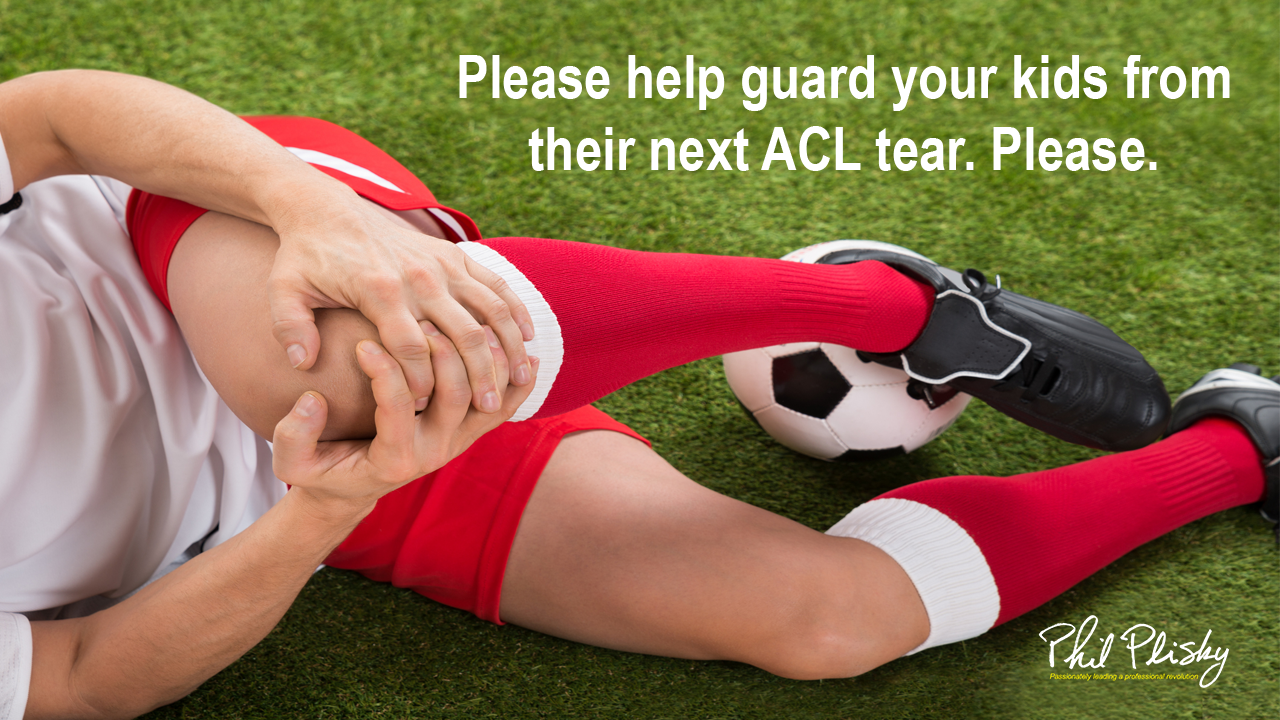
A Call to Parents
Please help guard your kids from their next ACL tear. Please.
As a father of 4 boys, protecting their health and well-being is of utmost importance to me. My wife and I believe sports participation offers our children physical, emotional, and leadership benefits. Unfortunately, sports injuries are costly both physically and emotionally. It seems that injuries are just part of the package. Or are they?
These injuries can be reduced. That’s right . . . we know how to reduce ACL tear risk and all of the subsequent misery. We know how to prevent ankle sprains and other maladies. The real problem is that we just can’t get parents and health care providers to take action.
Numerous researchers, myself included, have dedicated their lives to injury risk identification and prevention. So, what do we know? By combining multiple, easy to perform movement tests and other evidence-based risk factors, we were able to develop an injury risk algorithm that categorizes an athlete’s injury risk. We put the algorithm into a software application called Move2Perform, making injury risk category identification available to fitness and health care professionals globally.
A study by Lehr et al validated this algorithm in collegiate athletes. Lehr’s study demonstrated that athletes who were categorized by the Move2Perform software as being in the highest two risk categories were 3.5 times more likely to get hurt than their peers. Interestingly, no athletes who were in the optimal (lowest risk for injury) group were injured — apparently being “protected” from injury.
A similar algorithm has been developed for the U.S. military. Our ability to test and categorize many people quickly led a team of researchers to replicate the injury prediction in sports for the U. S. Military. The result was a 5 year research project called the MP3 study—Improving Military Power, Performance, through Prevention – which developed an injury prediction algorithm for our service members.
The methods and findings of this study are discussed in detail in this article. The bottom-line finding is that the more risk factors you have, the more likely the warrior athletes were to get hurt. Those factors included: prior injury, pain with movement, lack of full recovery from an injury, slower 2 mile run time, side to side difference in ankle mobility, poor balance and core control as measured by the Y Balance Test Lower and Upper Quarter.
But what can I do as a parent?
There are several steps parents can take to decrease their child’s risk of injury. Begin by embracing prevention. Like vehicles, bodies require preventative maintenance. Youth does not insulate your child from injury. A comprehensive movement “check up,” annually at minimum, is essential for musculoskeletal health.
In addition, here are 6 suggestions you can implement as a parent to help protect your child from injury:
1) Don’t have your child specialize in one sport too early or play too often. Using the guideline of no more hours per week in sports practice or competition than their age can solve a lot of problems
2) Find a provider using the best evidence available for your child’s movement screening
3) Be sure research-validated testing is performed pre-season and between sport seasons
4) Ensure that the risk factors identified during testing are corrected and verify that they have been corrected with re-testing
5) Once screening and testing are clear, have your child perform one of the many validated prevention programs (FitTo Play, SportsMetrics, Santa Monica PEP)
6) If your child does get injured, insist on a standardized, evidence-based return to sport testing prior to being released from medical care. Being pain-free and “feeling great at practice” is not sufficient.
I realize it is hard to make injury prevention measures a priority between all of the practices and games, but identifying and correcting faulty movement patterns is essential to musculoskeletal health. We schedule maintenance for our cars to avoid inconvenient breakdowns. We see the dentist twice a year for precisely the same reason. It’s time we embrace the wonderful truth about injury prevention—the chance of injury can be reduced.










